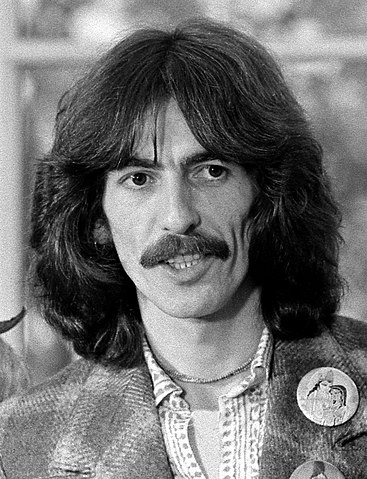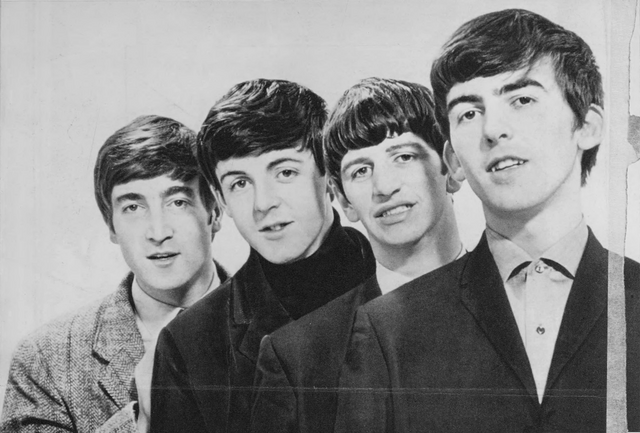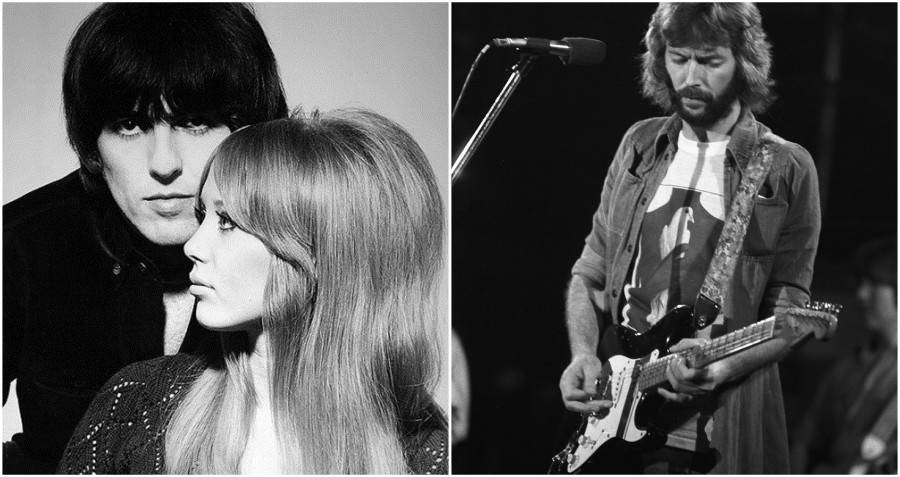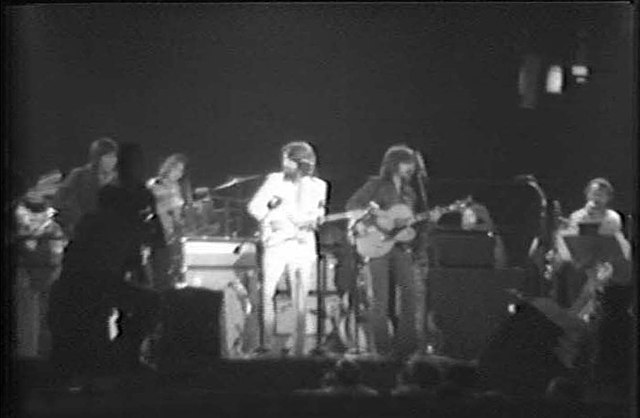When the Beatles first landed in the US, a guy who knew one or two things about music was unimpressed, predicting their metaphorical death.
That guy was Frank Sinatra, who would later change his mind and even cover their songs!
His favorite track was ‘Something’, from the ‘Abbey Road’ album. Before performing the song, he would introduce it as his favorite Lennon-McCartney song!
Good choice, Frankie!
The only problem is that ‘Something’ had been written and composed by George Harrison, the band’s lead guitarist!
This anecdote best captures the career and legacy of George Harrison. Known as ‘the quiet Beatle’, his musical contribution was often overlooked, fading in the shadow cast by those songwriting giants, John Lennon and Paul McCartney.
But as we’ll learn in today’s episode, George was far from being a wallflower and his musical talent was on par with the greatest stars of the 1960s and 1970s musical scene.

A Guitar Saved Me
George Harrison was born on February 25, 1943 in Liverpool, Northern England. He was the youngest of four children born to Harold,a bus driver and trade union official, and to Louise, a grocery store clerk.
George’s childhood was relatively peaceful and stable. But the Harrisons were not by any means wealthy, and their house in Liverpool was small, cramped, and terribly cold.
George’s parents signed him up at Dovedale primary school, the same one attended by John Lennon, but George was three years his junior and the two never met there.
Another Dovedale schoolmate remembered George as being a quiet guy, who nonetheless possessed a great sense of humor and liked to cause mischief. More importantly, he had a strong moral compass, defending schoolmates against bullies.
In 1949, the Harrisons moved to Speke, southeast of Liverpool. George continued with his studies, winning a place at the prestigious Liverpool Institute in 1954.
But young George did not fit well in this new environment. In plain terms, he was dead bored.
An intense love for popular music had swept away any interest in academics. As teachers lectured away, the skinny teenager filled his notebooks with drawings of guitars and lyrics from his favorite Elvis Presley songs.
George’s musical epiphany happened at the age of 13. While cycling around his neighborhood, he heard ‘Heartbreak Hotel’ by Elvis, drifting from an open window.
It hit him like a double decker bus. He knew what he wanted to be in life: he wanted to be a guitarist.
The young Harrison started dressing up as a Teddy Boy, sporting drainpipe trousers and a quiff. He listened avidly to Chuck Berry and Buddy Holly, as well as the early all-British skiffle records.
For the uninitiated, ‘skiffle’ is a sub genre of American folk music, often played with rudimentary and improvised instruments. After a surge in popularity in the 1920s, skiffle enjoyed a revival in Britain in the 1950s.
George wanted to rock. Or skiffle. Or both. And to do that, he needed money, encouragement, and a guitar.
He received all three from his parents, especially Louise who part-timed as a ballroom dancing instructor and was happy to indulge George’s musical inclination.
And so, the Harrisons bought George’s first guitar for £3 – not a small sum in times of post-war rationing!
He soon taught himself the first chords and his six-stringed beauty became his entire world. In Harrison’s own words:
‘When I was a kid growing up, the guitar was the main thing that saved me from boredom. It was the only job I could think of that I wanted to do … playing guitar and being in a rock band’
Eventually George graduated from the Liverpool Institute with only one O-level in art. Rather than continuing his studies, he apprenticed as an electrician.
But attendance to the Liverpool Institute had one positive consequence. While riding the bus back from school, George befriended an older schoolmate, whom he described as an ‘upperclassman’. That posh boy was none other than Paul McCartney!
Paul’s first impressions of George were of
“a cocky little guy with a good sense of himself; he wasn’t cowed by anything”
Ich Bin ein Hamburger
By the time George and Paul had become friends, the former had started taking his first steps in showbiz.
George and his brother Peter had formed a band, ‘Johnny and the Rebels.’
Their debut gig was at the British Legion Club in Speke. They had prepared just two songs because it was meant to be an audition … but when the main band failed to show up, they were asked to perform. They played those same two songs over and over, and returned home with their bellies full of ale and pockets stuffed with 10 shillings each.
Meanwhile, the foundations of the Beatles were being laid: in July of 1957, Paul McCartney joined the Quarrymen, John Lennon’s skiffle band.
In February of 1958, the group needed a new guitarist and Paul suggested they audition George. Lennon was not thrilled, as he didn’t want a 14-year-old kid in his band.
But he agreed to give him a chance, and an audition was organized. The three future Beatles met on the top floor of a double decker bus, and John asked the newbie to play ‘Raunchy’ by Bill Justis. When George launched into the twangy lead guitar riff, John gave his approval.
But Lennon later admitted he didn’t care much for George at the beginning:
“I couldn’t be bothered with him when he first came around … It took me years to come around to him, to start considering him as an equal.”
Shortly after the audition, The Quarrymen abandoned skiffle for the more promising rock and roll genre.
Wise move, as the combo was booked for a series of local gigs throughout 1959. In May 1960, the band changed its name to The Silver Beetles, and launched a two-week tour in Scotland.
That summer, the band was joined by drummer Pete Best. They were now a quintet: in addition to Best, there were George, John, Paul, and original bassist Stuart Sutcliffe.
The Silver Beetles were gaining in confidence and skill. So much so that their agent Allan Williams organized a residency at two clubs in Hamburg, Germany: the ‘Indra’ and the ‘Kaiserkeller.’
George played his first German gig on August 17, 1960. By then, the band had dropped the ‘Silver’ from their name and altered the spelling to ‘Beatles’ – a homage to the Beat generation.
Harrison and the guys played for eight hours straight on stage, for £2.50 a day. Not a fortune – but aged only, 17 George was earning more than his parents!
And there was another, priceless reward: the crowds of rowdy, yet adoring teenagers – mostly girls!
Soon the Beatles developed a reputation for rocking the brains out of their audiences, clearly outclassing every other band imported from Britain.

George knew it, mocking rival musicians as being ‘crumby’. He only had words of appreciation for the drummer of ‘Rory Storm and the Hurricanes’ … one Richard Starkey, aka Ringo Starr!
George gained confidence also in another aspect of rock and roll life: getting on with the ladies. It was in Hamburg that he lost his virginity. The other Beatles were in the room, pretending to ignore him, but could not help themselves from applauding at the end!
So, rock and roll: check! Sex: check! What was missing? Drugs of course!
To keep up with the demands of the Kaiserkeller club, George started taking prescription stimulants, which would cause him to froth at the mouth and to hallucinate.
The time spent in Hamburg was also a time of cultural growth for George. Due to his young age, he became a sort of mascot for a group of young intellectuals, including art student Astrid Kirchherr.
Thanks to their influence, the Beatles honed their image, ditching Teddy Boy quiffs for a look inspired by Parisian existentialists. The Beatles haircut was born!
Something else, far deeper, was being born in Hamburg: the power dynamics within the band. Lennon and McCartney already started competing for pre-eminence within the band, a duel fought with lyrics and melodies as weapons of choice. Harrison, still a junior member, was relegated to the back seat.
But from there, he observed, listened, and learned.
And he developed his signature lead guitar style, one that eschewed fretboard gymnastics, preferring carefully crafted riffs and short solos in which every single note had a purpose, every lick told a story.
But this early adventure was doomed to be short-lived.
In October 1960, the Beatles were booked by a new club, the ‘Top Ten’. Their Kaiserkeller promoter, Bruno Koschmider, was furious for this betrayal and got his revenge: he snitched to the police that Harrison was still a minor, resulting in his expulsion.
McCartney and Best retaliated by setting a condom on fire in one of Koschmider’s venues. Which resulted in their expulsion!
By December 1960, the Beatles were reunited in Liverpool, performing at the legendary Cavern Club.
Amongst the screaming, sweaty teenagers, sat one proud mum: Mrs. Harrison, singing along with the other fans!
The apple of her eye could not stay 17 forever. In April of 1961, once George had turned 18, the band returned to Hamburg.
Sacking Pete, Socking George
In June, they had the chance to record their first single, ‘My Bonnie’, which attracted the attention of Liverpudlian record shop owner Brian Epstein.
The band was invited back to their hometown by Epstein. In the meanwhile, Sutcliffe had decided to leave the band to marry their early muse Astrid Kirchherr.
Paul took on bass, and Epstein took them under their wing in November 1961, paving the way for the big break of the Beatles.
In February 1962, Brian sent an audition tape to major records label Decca, which was famously rejected.
It was a hard blow for the band, but Lennon later recalled how it was George who kept everybody’s spirits up.
Luckily, they listened to him, and they persevered! Another demo tape was well-received by Parlophone, an offshoot of EMI. In May of 1962, the band signed a record deal, and in June they started their first recording sessions.

During these early sessions, they were assigned a Parlophone producer, George Martin. He asked them:
“Let me know if there’s anything you don’t like”.
George Harrison replied:
“Well, for a start I don’t like your tie”
The two Georges did not get on well, but on one thing they did agree: Pete Best was not the right drummer for the Beatles. When Martin raised the issue with the other band members, Harrison enthusiastically suggested they hire his old pal from Hamburg, Ringo Starr.
Sometime in early September, a large Beatle fan showed up backstage at the Cavern Club and asked where Pete Best was. Harrison replied:
‘Oh, we sacked him.’
To which the fan socked him in the eye – and just left! George’s black eye can be seen on a September 1962 cover of magazine Mersey Beat.
In October of 1962, The Beatles released their first successful single ‘Love Me Do’.
Before long, Beatlemania had started. And the nation to embrace it more enthusiastically would be the US.
‘Don’t Bother Me’
The Fab Four from Liverpool started their tour across the Atlantic in February 1964, leaving a profound mark since appearing at the Ed Sullivan show. On that occasion, George was suffering from flu, which almost prevented him from playing, and made it difficult for him to speak at all.
Hence, the press and the public immediately dubbed him ‘The Quiet Beatle’!
Which wasn’t exactly true, but it matched his serious, dark persona and his growing dislike for the excesses of Beatlemania. He was in it for the music, and he soon grew tired of the constant barrage of unwanted public attention and hysterically screaming fans.
His sense of frustration was made worse by still being considered a ‘junior partner’ when it came to songwriting. Producer George Martin always gave precedence to the compositions by John and Paul, but Harrison was undeterred.
His first solo writing credit with the Beatles was ‘Don’t Bother Me’, written in August.
Harrison’s contribution to the Beatles sound however was not limited to penning songs. He also enriched his bandmates’ compositions with carefully crafted riffs and solos.
And he expanded the sonic palette of their productions by introducing new instruments and equipment.
For example, in 1964, he first picked up the Rickenbacker 12-string guitar, and later introduced to the Beatles’ sound the Moog and ARP synthesizers.
But the instrument which became the trademark of the Harrison sound was the sitar, the stringed instrument central to Indian traditional music.
George had first picked it up while shooting the film ‘Help!’, but he only started formal training on the instrument after meeting sitar virtuoso Ravi Shankar, in June of 1966.
George had been married since January 1966 with British model Patti Boyd, who encouraged him to expand his interest in Indian culture beyond the musical realm, and into a spiritual quest.

The Harrisons started studying yoga and meditation, attended lectures, and visited India in September of 1966.
By August of the following year, George had ‘converted’ the other three Beatles to the practice of Transcendental Meditation, popularized by the guru Maharishi Mahesh Yogi. In February of 1968, the band traveled to Rishikesh, India, where they spent several weeks of study and meditation with the Maharishi himself.
Ringo and Paul left the retreat early, but Lennon and Harrison remained until April. That’s when a scandal erupted, with allegations that the Maharishi had made improper sexual advances towards actress Mia Farrow.
John and George left Rishikesh, and in June the band made a statement distancing themselves from their guru. George, however, would later cast doubts on the allegations, and continued to support and fund his movement.
Hear Me Sigh
It could be argued that George Harrison’s interest in Indian music and culture was almost entirely responsible for their influence on the counterculture movement of the 1960s.
And his spiritual activism may have inspired in turn John Lennon’s own activism.
The Indian and Eastern influences, however, can be clearly appreciated on Harrison’s musical development.
For example, the lyrics to ‘While My Guitar Gently Weeps’ were inspired by the Chinese classic ‘Book of Changes’, or I Ching.
[Ee ching]
And what is perhaps Harrisons’ most famous song, ‘Here Comes the Sun’, features unusual time signatures, such as 11/8 and 7/8 [eleven eighths and seven eights] borrowed from Indian traditional music.
At the same time, George was developing a musical life outside of the confines of the Fab Four, forging friendships with legends Bob Dylan and Eric Clapton.
Clapton collaborated with George on his first solo album ‘Wonderwall Music’ of 1968, inspired by Indian music and blues-rock. This record was followed by a radical change in direction, 1969’s ‘Electronic Sound’: an atmospheric and sometimes disturbing avant-garde piece entirely performed on a Moog 3P Synthesizer.
So, all fine and dandy on the solo music production. But the ‘home front’ was not going so well.
George was a man of contrasts, and in this period, they were particularly exaggerated. At times he plunged into ascetic meditation, fueled by an increasingly dogmatic spiritual outlook. Other times, he liked to party hard and indulge in drugs, especially LSD and cannabis: on March 12, 1969, Harrison’s house was raided by the police, and the guitarist was charged with illegal possession of weed.
All the while, George and his wife Patti were unsuccessfully trying to conceive a child. The accumulating tensions led to the deterioration of their marriage – which progressed in parallel with the gradual dissolution of the Beatles.
During the last two years of activity of the band, 1969 and 1970, Harrison frequently clashed with Lennon and McCartney.
As usual, George’s compositions were overlooked or modified by John and Paul . Harrison retaliated by pointing out that since Yoko Ono had entered the picture, Lennon’s creative juices had dried up!
Harrison vented his frustrations in a new song, ‘Wah Wah’, which makes it clear how the Lennon-McCartney duo didn’t ‘hear him sighing’ – a reference to his musical and spiritual contributions.
‘Wah Wah’ didn’t make it to any of the last two Beatles’ albums, Abbey Road and Let It Be. It instead enriched the vast catalog of unpublished Harrison tunes, which would soon see the light of day.
The Quiet Gardener
In April 1970, the Beatles announced their split.
Music fans worldwide mourned … but George was rearing to go solo!
In November, he released his third album: ‘All Things Must Pass’.
This triple LP contains the popular track ‘My Sweet Lord’ … which unfortunately was at the center of a lawsuit! In February 1971, label Bright Tunes Music sued Harrison as the song was too similar to ‘He’s so fine’ by The Chiffons!
But the album contains more than 100 minutes of damn fine tunes!
And look out for Harrison’s first use of the slide guitar, which would become a signature technique.
Most of the album had been composed at George’s new lavish residence: Friar Park, an extravagant neo-Gothic mansion in Henley-on-Thames, Oxfordshire. George loved spending weeks of solitude and relaxation behind its walls, tending to the vast gardens.
Always a man of contrasts, George could spend a fortune on a new home, but at the same time dedicate great energy to alleviate the plight of the poor and desperate.

Harrison at the Concert for Bangladesh, August 1971. Credit: Richard Warren Lipack – Own work, CC BY-SA 3.0
In August of 1971, with help from Ravi Shankar, Bob Dylan and Ringo Starr, he organized two charity concerts in New York, collecting aid for the victims of floods in Bangladesh. The event would set the template for future rock charity concerts – think of Live Aid!
Professional success was counterpointed by further personal misery, however. His relationship with Patti took a huge hit in 1974, when she left him for his good friend Eric Clapton!
But Harrison did not really have the moral high ground, as he had been having several affairs, including one with Ringo Starr’s wife, Maureen.
In the same year, George undertook a tour in North America with Ravi Shankar. Harrison disappointed fans by refusing to play any Beatles song, while starting to feel the strain of life on the road.
The tour was a failure, but it had a silver lining.
While preparing it, George met Olivia Trinidad Arias, a marketing manager with A&M Records.
Olivia captured George’s interest thanks to a shared interest in meditation. Moreover, she was able to exert a positive influence on Harrison, curbing his excessive consumption of alcohol and drugs.
When George and Patti Boyd eventually divorced in 1977, he was ready to fully embrace a new life with Olivia.
On August 1, 1978, they welcomed their baby boy Dhani, and one month later they married at Henley register office. George was at his happiest when he could just chill with his family and spend long hours gardening in his Friar Park estate.
So much so that Dhani as a little boy had no idea that his father was a world famous rockstar! He recalled:
“I was pretty sure he was just a gardener.”
Besides gardening, George expanded his endeavors into other forms of artistic expression.
In 1979 he co-founded movie production company Handmade Films. It was thanks to Handmade that Monty Python could produce ‘Life of Brian,’ a religious satire which no other company dared funding. Harrison and Handmade produced other successes like ‘Time Bandits’, ‘The Long Good Friday’ and ‘Withnail and I.’
But Harrison also bankrolled stinkers like ‘Shanghai Surprise,’ one of several wrong decisions which eventually bankrupted Handmade Films.
In 1980, George also picked up the typewriter, authoring his autobiography ‘I Me Mine.’
In it, he avoided any mention of John Lennon, to which the former Beatle took great offense. Harrison tried to contact him to resolve their issues, but fate got in the way in the shape of gunman Mark David Chapman, who shot Lennon on December 8, 1980.
Now, the Beatles were truly history.
All Things Must Pass
George continued to compose throughout the 1980s, releasing two solo albums, one compilation, and two records with a super-group of super-musical friends: the Traveling Wilburys.
The band was founded in April 1988, as a brainchild of Harrison’s and Jeff Lynne, of Electric Light Orchestra. The duo recruited three musicians, which you may have heard of: Roy Orbison, Tom Petty – and Bob Dylan!
The Wilburys were anything but Traveling, as they never went on tour. But their success encouraged George to organize his last ever set of gigs. Despite the Boyd-Clapton affair the two guitarist friends had never fallen out, and they decided to tour Japan in 1991 and 1992.
This would be the last time that George performed in public.
His health had already started to deteriorate, and in 1997 he was diagnosed with throat cancer, a result of a life of excesses and heavy smoking.
The initial treatment was successful, but it would be a short-lived respite.
In the early hours of December 30, 1999, Michael Abram, a paranoid schizophrenic, managed to sneak into Friar Park armed with a kitchen knife.
Harrison tackled the intruder, but Abram fought him off, and stabbed him 40 times, puncturing one of his lungs. Luckily Olivia intervened, knocking out the would-be killer with a table lamp.
Harrison recovered quickly from the attack, quipping that Abram
“certainly wasn’t auditioning for the Traveling Wilburys.”
But according to Olivia, the wounds only contributed to George’s declining health.
In fact, his cancer returned, this time affecting his lungs, and later the brain.
After further treatment in Switzerland and the US, George Harrison died in Los Angeles on November 29, 2001.
His spirits were up until the very end. Shortly before his death, he was still cracking jokes with his old pal Ringo Starr.
According to George’s wishes, his ashes were dispersed in the river Ganges.
At the peak of his artistic activity with the Beatles, George Harrison may have struggled to have his voice heard, but he was successful in steadily building a legacy of profound, inspiring music spanning at least four different genres.
Ten years after his death, Dhani Harrison returned to Friar Park and noted how the garden had never looked better. The trees planted by his father had finally grown.
He remarked:
“You don’t build a garden for yourself, right now — you build a garden for future generations. My father definitely had a long view.”



